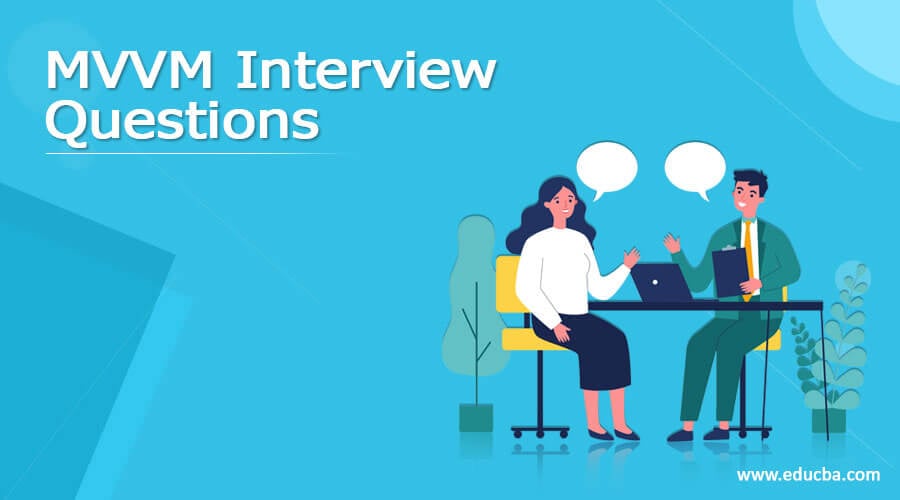Updated April 4, 2023

Introduction to MVVM Interview Questions
MVVM is an abbreviation of the Microsoft design pattern Model-View-ViewModel. “Presentation Model” is Martin Fowler’s specialization of the MVC pattern. Model and ViewModel are the 3 roles of this pattern. As in MVC, View and Model play the same roles. Model-View-Controller (MVVM) views the Model as if it were a special controller for a View. The ViewModel exposes data from the Model to the View and provides action and logic for user requests from the View. This type of abstraction contains the state and behavior of the View.
MVVM Interview Questions
Let have a look at the MVVM interview question.
1. Explain the elements of MVVM?
Answer: There are three elements which are View mode, View, Model let have a look at each one by one
- View: All elements displayed by the GUI, such as labels, buttons, and other controls, are included in the view.
Model: (a) a domain model which represents the real-state content, (b) the data access layer which represents that content (a data-centric approach). - View model: Essentially, the view model is a “model of the view” that serves as a mediator between the view and the model, which is the target of the view’s data bindings (the model).
2. What do you mean by data binding?
Binding data sources and targets is the process of connecting data sources to their targets. The data target receives the data from the data source and uses it to make decisions. Any CLR object can be the data source. If the data target is usually a textbox or Combobox, the data target is usually a WPF element. As a result of the automatic synchronization of data in WPF data binding, source and target data changes are automatically reflected in the data. This is also true when a change is made to one or more fields of a database or data target.
3. Explain dependency property
Dependency properties enhance the normal CLR property system by adding certain features. The DependencyObject class is the ancestor of the class that defines dependency properties. DependencyObject is usually inherited by WPF controls. Dependency properties are therefore supported by UI controls.
4. What is a Command?
Commands are used to decouple an object that issues a command from the logic that follows. Many different UI control actions can raise the same command and execute logic using this technique. Copy and cut actions, for example, can both invoke the same command. Better separation of concerns is achieved because the logic that handles the action is decoupled from the control that raises the event, allowing for better separation of concerns.
5. What is Prism in WPF?
Create applications in WPF and Silverlight with a single code base by using Prism (Composite Application Guidance for WPF and Silverlight). In this way, a large application’s complexity can be broken down into simpler modules.
6. What is ART?
Android Run Time is what it’s called. Runtime for Android applications is provided by Android Application Runtime (ART). On the device, AOT (Ahead Of Time) compilation is used to compile the code. APK files with.dex extensions are converted to native instructions set/machine code (.art extension) and stored in the app’s runtime cache directory on the device’s internal storage when an APK is installed. It will take a little longer to install and take up more space on the device’s storage, but it will make apps run faster, use less battery power, and provide a better user experience.
7. What are Resources in WPF?
Using WPF resources, you can reuse objects and values that are commonly defined. You can set the properties of multiple controls at once using WPF’s resources. You can, for example, use a single resource to set the background property on multiple elements in a WPF application. When defining resources, it’s best to do so at the Window or Page element level. Each element’s child elements are affected by the resources you define for it. The resources defined for the window elements, for example, can be used by the grid element. As an exception to this rule, if you define a resource for a grid component, that resource only applies to the grid element’s child elements
8. What is a value converter in WPF and how does it work?
You need a Value Converter when your target is bound to only one input source, as in the case of text boxes and buttons. As soon as the text box is filled or null, you want to enable or disable the button. String data must be converted to Boolean in this situation. Value Converters make this possible. In order to implement Value Converters, the System must inherit from I Value Converter. Windows. Convert and Convert Back methods are implemented in the data namespace.
9. Can you list out the features of MVVM
There are many features of MVVM lets have a look at some:
i. Enhance testability and simplicity.
ii. Command, Powerful Data Binding, validation, and many more.
iii. In MVVM developers and designers can work together.
iv. Allow a better Developer/Design Workflow.
Conclusion
That concludes our list of the most popular MVVM interview questions and answers. Reading this list will undoubtedly help you in tightening up your MVVM interview preparation. We hope you will find this article helpful.
Recommended Articles
This is a guide to MVVM Interview Questions. Here we discuss the Introduction, list of the most popular MVVM interview questions, and answers. You may also have a look at the following articles to learn more –
